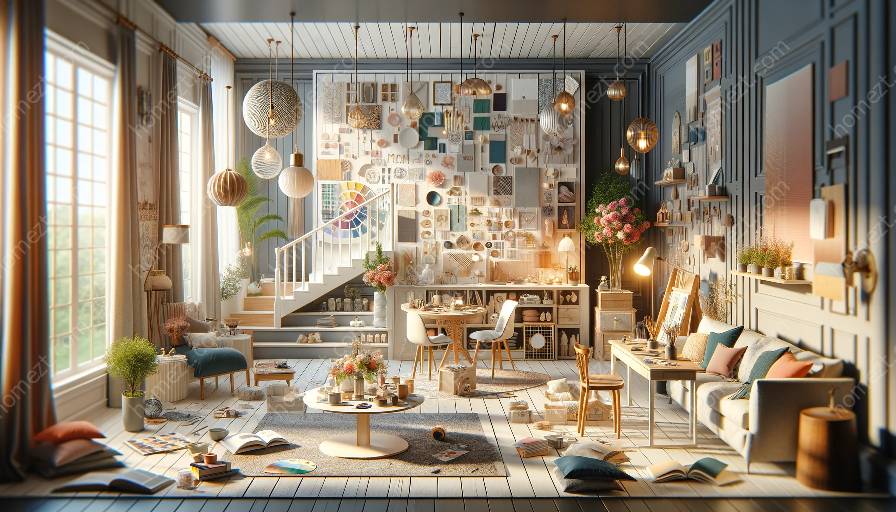Integrating technology into interior design brings a plethora of benefits, transforming and enhancing traditional design concepts. The infusion of technology complements mood boards and design concepts, and can revolutionize interior design and styling.
Enhanced Visualization and Immersion
Technology allows designers and clients to visualize and experience interior design concepts in a more immersive and realistic manner. Virtual reality (VR), augmented reality (AR), and 3D modeling tools provide opportunities to walk through a space before it is constructed, creating a more accurate representation of the final design. This enhances communication between designers and clients, ensuring a shared understanding of the vision and reducing the likelihood of misunderstandings.
Efficient Space Planning and Layout
Utilizing advanced software and tools enables interior designers to efficiently plan and layout spaces. With the help of technology, designing intricate floor plans, arranging furniture, and experimenting with different spatial configurations becomes more seamless. This streamlines the design process and allows for greater exploration of design possibilities, leading to optimized use of space and functionality.
Personalized Customization
Technology facilitates personalized customization, allowing clients to tailor interior design concepts to their specific preferences. Through the use of digital mood boards, online design platforms, and interactive visualization tools, clients can actively participate in the design process, making selections based on their individual style, color palettes, and material preferences. This level of customization enhances client satisfaction and fosters a sense of ownership in the design outcome.
Sustainability Integration
Integrating sustainable technology into interior design concepts has become increasingly crucial. From energy-efficient lighting systems to smart home automation, technology offers solutions that contribute to environmentally friendly and sustainable design practices. By incorporating sustainable elements and materials into design concepts, interior designers can create spaces that are not only aesthetically pleasing but also environmentally conscious, aligning with modern trends and ecological responsibilities.
Smart Home Integration
Advancements in technology have given rise to the concept of smart homes, and interior designers play a pivotal role in integrating these innovations seamlessly into residential spaces. From smart lighting and climate control to automated security systems, incorporating smart home technology enhances the functionality and convenience of living spaces. Designing with technological infrastructure in mind allows for the seamless integration of IoT devices, creating cohesive, connected environments that prioritize both aesthetics and functionality.
Seamless Integration of Audiovisual Systems
Integrating technology extends to the incorporation of audiovisual systems that elevate the overall ambiance and entertainment experience within a space. Home theaters, integrated sound systems, and concealed wiring solutions are examples of how interior design can seamlessly integrate technology to enhance the audiovisual experience. The unification of technology and design creates spaces that are not only visually appealing but also optimized for entertainment and relaxation.
Effortless Maintenance and Management
Technology simplifies the management and maintenance of interior spaces. Automated systems for lighting, climate control, and security not only enhance the comfort and safety of occupants but also reduce the effort required for upkeep. Additionally, the integration of smart technology allows for remote monitoring and management, providing homeowners with greater control and peace of mind.
Collaborative Design Platforms
Technology fosters collaboration and communication within the interior design industry. Online platforms and digital tools enable designers, clients, and suppliers to collaborate in real-time, streamlining the design process and allowing for efficient sharing of ideas and feedback. This collaborative approach enhances the overall design experience and promotes a more cohesive and inclusive design process.
Futuristic Design Aesthetics
Embracing technology in interior design allows for the exploration of futuristic aesthetics and innovative design concepts. From interactive art installations to kinetic architecture, technology inspires a new wave of design possibilities that challenge traditional norms and push the boundaries of creativity. This creates opportunities for designers to craft truly unique and captivating spaces that resonate with contemporary and forward-thinking design trends.
Integrating technology into interior design concepts not only brings about numerous benefits but also aligns with the evolving needs and expectations of modern clients. By complementing mood boards, design concepts, interior design, and styling, technology becomes an indispensable tool that enables designers to create immersive, sustainable, and personalized spaces that seamlessly integrate the latest technological advancements.


























